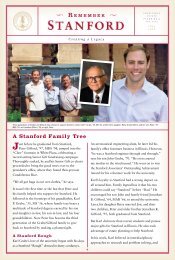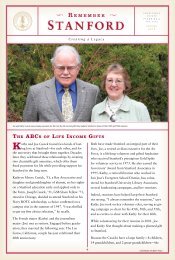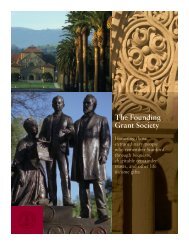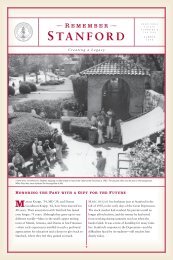Creating a Charitable Lead Annuity Trust [PDF] - Giving to Stanford
Creating a Charitable Lead Annuity Trust [PDF] - Giving to Stanford
Creating a Charitable Lead Annuity Trust [PDF] - Giving to Stanford
Create successful ePaper yourself
Turn your PDF publications into a flip-book with our unique Google optimized e-Paper software.
<strong>Creating</strong> a <strong>Charitable</strong> <strong>Lead</strong> <strong>Annuity</strong> <strong>Trust</strong><br />
Planning for your family’s financial future?<br />
Minimize taxes while helping <strong>Stanford</strong>.<br />
Seeking Solutions, Educating <strong>Lead</strong>ers<br />
Rolling oRange
Through a <strong>Stanford</strong> charitable lead annuity trust, you can make<br />
significant annual gifts <strong>to</strong> <strong>Stanford</strong>, benefit from the proven investment<br />
expertise of the <strong>Stanford</strong> Management Company, and reduce<br />
the tax burden on your heirs.<br />
<strong>Creating</strong> a <strong>Charitable</strong> <strong>Lead</strong> <strong>Annuity</strong> <strong>Trust</strong><br />
Rebecca Smith Vogel<br />
Are you concerned about the tax consequences of leaving money<br />
<strong>to</strong> your children? Do you intend <strong>to</strong> support <strong>Stanford</strong> during your<br />
lifetime through generous annual gifts? <strong>Creating</strong> a charitable lead<br />
annuity trust (CLAT) at <strong>Stanford</strong> may be the most advantageous<br />
way for you <strong>to</strong> realize your philanthropic and wealth management<br />
goals.<br />
This type of trust1 is recognized under provisions of the Internal<br />
Revenue Code and has been employed in the estate plans of high<br />
net worth individuals for many years. A CLAT makes a fixed annual<br />
payment <strong>to</strong> charity for a stated period of years, after which the<br />
remaining assets are transferred <strong>to</strong> your children or other named<br />
beneficiaries. This gift <strong>to</strong> your heirs is valued for gift and estate tax<br />
purposes at its “present value” as of the date the trust is established,<br />
utilizing a discount rate issued by the IRS that varies from month<br />
<strong>to</strong> month. The tax advantages are greatest when a trust is created<br />
while interest rates are low.<br />
A CLAT is a mutually beneficial arrangement. In addition <strong>to</strong> substantial<br />
tax savings for you and your heirs, this form of giving provides<br />
<strong>Stanford</strong> an assured flow of funds for a period of years, allowing<br />
better planning and budgeting.<br />
1 There are several other types of charitable lead trusts not discussed in this document. Please consult your<br />
advisors and/or contact the professional staff in the Office of Planned <strong>Giving</strong> for further information.<br />
The STanford Challenge
chuck PainteR<br />
Is a CharItable lead annuIty trust rIght for you?<br />
• Are you and/or your estate subject <strong>to</strong> gift and/or estate taxes?<br />
• Do you want <strong>to</strong> make significant annual gifts <strong>to</strong> <strong>Stanford</strong>, perhaps in amounts larger than<br />
you can typically deduct from your income taxes?<br />
• Do you have either cash or assets likely <strong>to</strong> appreciate significantly that you can part<br />
with now?<br />
• Do you believe that investments will earn a compound annual return over the period of the<br />
trust that is more than the current IRS discount rate?<br />
• Do you want <strong>to</strong> maximize your children’s (or others’) inheritance?<br />
• Would you prefer your children (or others) wait a number of years for this inheritance?<br />
If the answer <strong>to</strong> some or all of these questions is “yes,” a CLAT may be a good option for you.<br />
By having your heirs wait for a period of years <strong>to</strong> receive their gift, all the assets distributed<br />
from the trust at the end of that time will pass <strong>to</strong> them free of gift and estate taxes. Because<br />
their right <strong>to</strong> receive the remaining trust assets is established at the time the trust is created,<br />
there may be a current gift tax payable. By creating a CLAT, however, you are entitled <strong>to</strong> a<br />
significant tax deduction that will reduce—or even eliminate entirely—the gift tax, depending<br />
on the size of the annual payout <strong>to</strong> <strong>Stanford</strong> and the number of years the trust will make such<br />
payouts before the children or other designated beneficiaries get the remaining assets.<br />
tax benefIts of a CharItable lead annuIty trust<br />
Income tax<br />
There are no income tax charitable deductions for this type of trust. But the income<br />
produced by the trust assets is no longer a part of your personal taxable income, and the<br />
annual payments <strong>to</strong> <strong>Stanford</strong> are deductible from the trust’s taxable income. This may<br />
be especially advantageous if you tend <strong>to</strong> exceed your charitable deduction limit on your<br />
income taxes each year.<br />
gift tax<br />
Your gift tax charitable deduction is calculated based on the number of years the trust<br />
will make payments <strong>to</strong> <strong>Stanford</strong>, the payout rate chosen, and the IRS discount rate in<br />
the month the trust is funded. A lower IRS discount rate, a higher payout <strong>to</strong> <strong>Stanford</strong>,<br />
and a longer charitable term will result in a larger deduction, and in some cases will<br />
make the entire gift <strong>to</strong> your children tax free.<br />
estate tax<br />
If you make a CLAT gift while you are living, the transferred assets will be out of your<br />
estate, eliminating probate fees and inheritance taxes on those assets. You may also<br />
provide for a testamentary CLAT in your estate plans, which can substantially reduce—or<br />
even eliminate—the estate tax on the gift.<br />
Rebecca Smith Vogel
Remainder<br />
<strong>to</strong> Children<br />
or Others<br />
3<br />
how does It work?<br />
LEAD<br />
TRUST<br />
2<br />
Fixed Yearly<br />
Payments<br />
<strong>to</strong> <strong>Stanford</strong><br />
Richard Mita is in high income, gift, and estate tax brackets, and he has used all of his<br />
$1 million gift tax exemption for lifetime gifts. He would like <strong>to</strong> make a substantial gift <strong>to</strong><br />
<strong>Stanford</strong>, using assets that he wants <strong>to</strong> eventually go <strong>to</strong> his children. If he makes an outright<br />
gift now <strong>to</strong> his children, he will incur substantial gift tax. If he defers making his gift, and the<br />
assets meanwhile appreciate in value—as he expects they will—the eventual gift tax (or estate<br />
tax, if given by will) could be even higher, because the tax will be based upon the appreciated<br />
value of the assets at the time of the gift.<br />
Instead of giving the assets directly <strong>to</strong> his children, Richard funds a CLAT with suitable assets<br />
(usually cash or assets that have a high likelihood of significant appreciation) currently valued<br />
at $1 million. Paying a fixed 7.5 percent annuity ($75,000) <strong>to</strong> <strong>Stanford</strong> for 20 years will result<br />
in a full $1 million gift tax deduction, which “zeroes out” the value of the gift for tax purposes<br />
so that when the trust terminates, all the remaining assets will pass <strong>to</strong> the children free of gift<br />
and estate taxes. If the trust term were reduced <strong>to</strong> 15 years, the gift tax deduction would be<br />
$846,300, meaning that there would be a taxable gift <strong>to</strong> the children in the amount of only<br />
$153,700. At current gift tax rates, the maximum tax would be $69,165. This reflects the<br />
fact that the children would receive their gift earlier and less would be paid out <strong>to</strong> <strong>Stanford</strong>. By<br />
further reducing the term <strong>to</strong> 10 years, the gift tax deduction would be $617,380, meaning<br />
that there would be a taxable gift <strong>to</strong> the children in the amount of $382,620. At current gift tax<br />
rates, the maximum tax would be $172,179. (These figures assume a 4 percent IRS discount<br />
rate for the month in which the trust is funded.)<br />
If the assets have grown at a steady 10 percent annual return (6 percent above the IRS discount<br />
rate we assumed in our example for calculating the tax deduction, above), the children<br />
will receive around $2.4 million at the end of 20 years; $1.8 million at the end of 15 years;<br />
or $1.4 million at the end of 10 years. In each case, these amounts will be distributed <strong>to</strong><br />
the children free of gift and estate tax. And of course, <strong>Stanford</strong> will have received a <strong>to</strong>tal of<br />
$1,500,000, $1,125,000, or $750,000, respectively.<br />
1<br />
Donor<br />
Transfers<br />
Property<br />
The STanford Challenge<br />
l. a. ciceRo/StanfoRd newS SeRVice<br />
l. a. ciceRo/StanfoRd newS SeRVice
how do I Create a CharItable lead annuIty trust wIth stanford?<br />
The steps necessary <strong>to</strong> establish such a trust are relatively simple:<br />
1. Determine who will act as trustee. <strong>Stanford</strong> is willing <strong>to</strong> serve in many cases.<br />
2. Sign a trust agreement establishing the trust. <strong>Stanford</strong> has sample forms and<br />
examples of documents used by others.<br />
3. Transfer assets in<strong>to</strong> the trust name.<br />
a few thIngs <strong>to</strong> ConsIder<br />
• CLATs are taxable trusts, subject <strong>to</strong> tax on any ordinary or realized capital gains income.<br />
The amounts paid by the trust <strong>to</strong> <strong>Stanford</strong> are deductible, but any realized income in excess<br />
of that amount will be subject <strong>to</strong> the usual federal and state income taxes.<br />
• CLATs are irrevocable and not subject <strong>to</strong> amendment. Once established, they remain in effect<br />
according <strong>to</strong> their terms. No distribution from the trust is allowed even in the event of family<br />
hardship, financial reversals, or medical emergencies.<br />
• The assets distributed from a CLAT do not have a “stepped-up” basis, so the sale of any<br />
appreciated assets eventually distributed <strong>to</strong> your children or other individual, non-charity<br />
beneficiaries will be subject <strong>to</strong> capital gains taxes.<br />
• There is no guarantee that the investment return on the trust assets will exceed the IRS<br />
discount rate used <strong>to</strong> calculate the “present value” of the gift <strong>to</strong> the children; in fact, there is<br />
no assurance of any particular return.<br />
• Because the annual payments <strong>to</strong> <strong>Stanford</strong> are fixed, it is possible that all of the trust assets<br />
could be consumed prior <strong>to</strong> the end of the trust term, so that nothing would be available for<br />
distribution <strong>to</strong> your heirs.<br />
Depending upon your personal and family situation and the particular assets you hold, a number<br />
of related matters should be discussed. The professional staff in the Office of Planned <strong>Giving</strong><br />
can help you and your advisors design the arrangement that is best for your circumstances.<br />
l. a. ciceRo/StanfoRd newS SeRVice
A CLAT is an easy and effective way <strong>to</strong> support <strong>Stanford</strong> while preserving wealth for your<br />
family. And during The <strong>Stanford</strong> Challenge, there are many exciting opportunities <strong>to</strong> support<br />
the university and the world beyond. The <strong>Stanford</strong> Challenge is a five-year campaign aimed at<br />
seeking solutions <strong>to</strong> complex, global problems and educating the next generation of leaders.<br />
For example, the campaign includes university-wide initiatives on three major themes—human<br />
health, the environment and sustainability, and international peace and security. Whether the<br />
goal is curing cancer, preserving the health of the world’s oceans, or understanding the root<br />
causes of terrorism, the opportunities created by The <strong>Stanford</strong> Challenge have the potential <strong>to</strong><br />
make a real difference in people’s lives all over the world.<br />
Please visit the campaign Web site for more information at: thestanfordchallenge.stanford.edu.<br />
here are just a few examples of ways that you mIght opt <strong>to</strong> support<br />
stanford through your CharItable lead annuIty trust:<br />
• Create a scholarship endowment that will carry your name or that of someone you<br />
wish <strong>to</strong> honor in perpetuity while helping <strong>to</strong> ensure that <strong>Stanford</strong> can continue <strong>to</strong><br />
admit the most qualified applicants, regardless of their financial need.<br />
• Establish a fund <strong>to</strong> support innovative multidisciplinary research through one of<br />
the three initiatives on human health, the environment and sustainability, or international<br />
peace and security.<br />
• Support <strong>Stanford</strong>’s efforts <strong>to</strong> improve K–12 education.<br />
• Help <strong>Stanford</strong> infuse creativity throughout the curriculum through the Arts Initiative.<br />
• Provide a graduate fellowship in an area that is most interesting <strong>to</strong> you.<br />
• Enable <strong>Stanford</strong> <strong>to</strong> stay at the forefront of scientific and technological research by<br />
helping us build cutting-edge facilities.<br />
• Support a specific sports program.<br />
Note: Matching funds may be available. Check with the Office of Planned <strong>Giving</strong><br />
for details.<br />
Rebecca Smith Vogel<br />
contact uS<br />
For more information about establishing a<br />
charitable lead annuity trust at <strong>Stanford</strong>,<br />
please contact:<br />
Office of Planned <strong>Giving</strong><br />
Frances C. Arrillaga Alumni Center<br />
326 Galvez Street<br />
<strong>Stanford</strong>, CA 94305-6105<br />
1.800.227.8977, Ext. 54358 (T)<br />
650.723.6570 (F)<br />
planned.giving@stanford.edu (E-mail)<br />
plannedgiving.stanford.edu (Web)<br />
The STanford Challenge<br />
michael SilVa<br />
mai nguyen


![Creating a Charitable Lead Annuity Trust [PDF] - Giving to Stanford](https://img.yumpu.com/19129374/1/500x640/creating-a-charitable-lead-annuity-trust-pdf-giving-to-stanford.jpg)



![Leadership Giving: Stanford Reunion Campaigns 2013 [PDF]](https://img.yumpu.com/19129379/1/190x245/leadership-giving-stanford-reunion-campaigns-2013-pdf.jpg?quality=85)
![Leadership Giving to The Stanford Fund [PDF] - Giving to Stanford ...](https://img.yumpu.com/19129353/1/190x245/leadership-giving-to-the-stanford-fund-pdf-giving-to-stanford-.jpg?quality=85)
![Undergraduate Financial Aid: A Defining Commitment [PDF]](https://img.yumpu.com/19129351/1/190x245/undergraduate-financial-aid-a-defining-commitment-pdf.jpg?quality=85)

![The Stanford Fund for Undergraduate Education [PDF] - Giving to ...](https://img.yumpu.com/19129349/1/190x245/the-stanford-fund-for-undergraduate-education-pdf-giving-to-.jpg?quality=85)
![Stanford Interdisciplinary Graduate Fellowships [PDF] - Giving to ...](https://img.yumpu.com/19129346/1/190x245/stanford-interdisciplinary-graduate-fellowships-pdf-giving-to-.jpg?quality=85)
![Donor Advised Funds [PDF] - Giving to Stanford - Stanford University](https://img.yumpu.com/19129344/1/190x245/donor-advised-funds-pdf-giving-to-stanford-stanford-university.jpg?quality=85)

